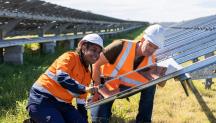

-
-
IRENA (2017), Renewable energy benefits: Leveraging local capacity for onshore wind, International Renewable Energy Agency, Abu Dhabi.
Copied
/-/media/Files/IRENA/Agency/Publication/2017/Jun/IRENA_Leveraging_for_Onshore_Wind_2017.pdf?rev=81edbcc6ba534936a4b6d0360e519df1
Copied
Renewable Energy Benefits: Leveraging Local Capacity for Onshore Wind
Newsletter
The series aims to support policy makers and decision makers, particularly in assessing the feasibility of procuring components and services domestically rather than from abroad.
Increasingly, many countries see socio-economic benefits as a major reason to pursue renewable energy development, recognising job creation as an important co-benefit. Employment opportunities arise throughout the value chain, from project planning, manufacturing and installation, to operation, maintenance and eventual decommissioning.
According to the analysis of the International Renewable Energy Agency (IRENA), the sector could support 26 million jobs worldwide by 2050, given sufficient deployment of renewables and energy efficiency to meet the goals laid out in the 2015 Paris Agreement. Compared to current plans and policies, such accelerated deployment would boost global GDP by 0.8%.
Leveraging studies have been released for offshore wind, solar photovoltaic and solar water heaters




